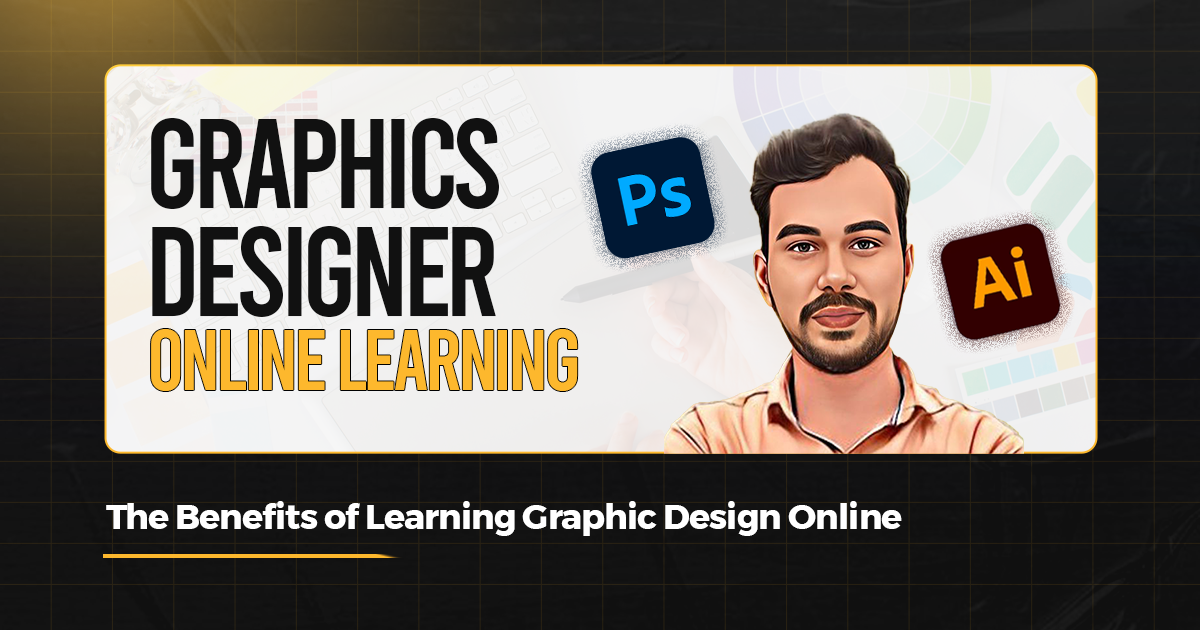
One of the most important specializations today is graphic design and it’s also essential in marketing, advertising, web development, and branding. With the rise in importance of visual content, there is a shift among businesses and people towards needing proficient designers for visually appealing materials. In the past, graphic design had only been taught in academic establishments, but this has completely changed with the emergence of online learning networks.E-learning on graphic designing has many advantages such as, more affordable, more convenience and cut across geographical limitations. This article delves into the benefits of learning graphic design online as well as its shortfalls.
Also Read: Understanding the Fundamentals of UI/UX Design
- Cost-Effectiveness
An edge to competitive practice in graphic design learning spaces particularly in an online learning setting is the cost benefit. A single degree program from a university would cost one an arm and a leg, however interactive webinars open up at hugely discounted rates and the tasks professionally geared towards graphics one might wish to acquire are slashed at a fraction of the price.
- Lower Tuition Fees: Traditional degree programs charge unreasonable rates, where graphic designing courses range within $10–50 on online sites like Coursera, Udemy, and Skillshare.
- No Commuting Costs: Public transportation, the cost of accommodation or setting up a campus becomes irrelevant when one is pursuing online courses.
- Free Learning Resources: Various online platforms such as Youtube offer free tutorials alongside professionally prepared video sessions.
Such cost reductions enable students to purchase important design materials, for example, high-performance laptops or Adobe Creative Suite.
- Convenience and Flexibility
The reader may confirm that online learning has a flexibility that cannot be obtained in traditional schools. Designers in the making can learn at the pace which best suits them, which is a suitable option for students, employed people and freelancers alike.
- Self-Paced Study: Numerous courses enable students to complete this at different rates allowing for various timings to accommodate them.
- No Spatial Limitations: Students do not have to reside at a particular place in order to get enrolled at the best global universities and professionals’ courses.
- 24/7 Online Availability: Resources can be available at any time making it convenient for the learners to study when they are comfortable.
This is true for people who want to learn graphic designing, but are too busy with other activities such as a job.
- Global Resources and Experts’ Access
Learning online has shone its light in connecting students with experienced professional teachers and educators in the field.
- Expert Led Courses: Leaders in the industry offer courses on such platforms as LinkedIn Learning or Domestika where real-life experiences are shared during teachings.
- Networking Opportunities: Online communities, forums, webinars and all virtual events enable the learner to interact with designers from across the globe.
- Revised Content: Online platforms and even course instructors take care to modify existing programs to better fit the course with the present day requirements of the designing industry.
This guarantee means that better quality education that is relevant to the modern world and industry is provided to the students.
- Project Based Assignments
These online graphic design courses allow learners to gain relevant experience and accumulate a strong portfolio of their work.
- Practical Project Application: Sites such as Udacity and Interaction Design Foundation offer real-life projects directed towards the students.
- Portfolio Creation: Some courses request students to design several projects that can later be used for their portfolios.
- Certificates And Badges: Certificates are often given at the end of the course as a supplement to one’s career.
The knowledge and skills students acquire here prepare them for freelancing as well as employment within the said industry.
- Keeping Updated with Current Software and Tools.
Designing graphic content can only be possible by using software, which most students acquire during training from any of the numerous online programs.
- Adobe Creative Suite (Photoshop, Illustrator, InDesign): A majority of the training centers emphasize the need for the three most popular tools in the graphic design industry.
- Canva and Figma: More course content offered in online classrooms now integrates the use of tools such as Canva and Figma that are easier to use and adapt.
- Motion Graphics and UI/UX Software: With the inclusion of After Effects, Sketch, and Adobe XD in the course outline, designers’ skill range is set to expand.
Exposure to such tools on a global scale and learning them online will mean that such designers remain versatile and relevant.
- Work Possibilities and Professional Progression.
The employment opportunities for those with skills in graphic design are becoming more and more in demand. Online methods of teaching offer avenues for professional development.
- Freelance Opportunities: A great percentage of online learners begin freelancing at Fiverr, Upwork and Behance while still in college and other schools.
- Corporate and Agency Jobs: Among the applicants for positions in marketing, branding, and the digital space, those completing online courses and obtaining certifications will be in a much better place.
- Entrepreneurship: A number of self taught designers start their own businesses focusing on logo design, web design and social media graphics.
In the period spanning from 2020 to 2030, there is a growth in demand for graphic designers, especially for services in web design and digital marketing, as the Bureau of Labor Statistics projects an increase of 3% in employment opportunities within this profession.
- Tailored Educational Approach
Different from conventional learning settings, online courses enable students to design their educational journey according to their interests and abilities.
- Optimized for Students At All Levels Of Ability: Some courses are designed to take the participant from one end to the other of the skill spectrum.
- Wide Variety In Learning Aids: Learning can be achieved through video tutorials, e-books, interactive exercises as well as live Q&A sessions among others.
- Targeted Areas Of Focus: Such as typography, branding, UI/UX and motion graphics among others
This person-centered model addresses the student’s employment opportunities by offering students skills that are required in the industry.
- Skill Acquisition and Improvement
Graphic design is one of the fastest growing and expanding fields and that means a designer should always be in touch with online education enabling them to:
- Follow the Trends: Design courses are always up to date so if minimalism is the trend, or if 3D design or augmented design takes over courses are updated to include it.
- Recognize New Practices: New concepts are introduced because of online platforms ranging from interactive media to seems AI-created designs
- Attend Advanced Certifications: Designers based on their need have started taking certification courses which helps them expand their portfolio such as Google’s UX Design Certificate
Constant Learning also allows the designers to stay relevant in a fast paced world and remain on top of their game.
Conclusion
Online courses for graphic design are cost-effective and highly flexible. There is also great potential for career growth and improvement of previously acquired skills. With the availability of expert-designed courses, access to industry-grade tools, and a high pool of professionals, the students have all the means necessary to get ahead in the field.
Learning graphic design online and making use of the skill learned helps in getting into the graphic design industry. Online courses are a great starting point for anyone planning to go self-employed, get a job, or become a business owner.

